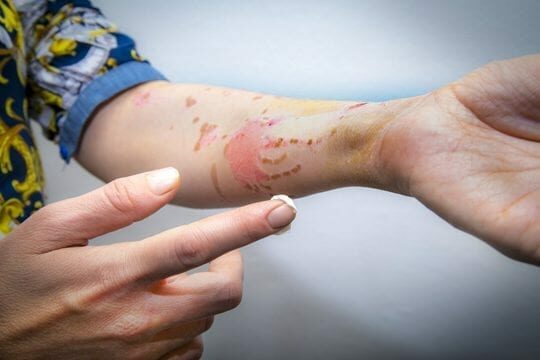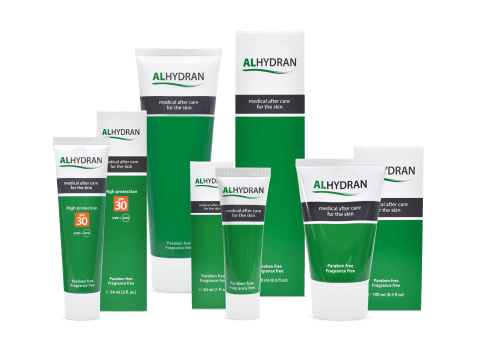Burn wounds
A burn can leave visible marks on the skin. Additionally, burn wounds can cause complaints such as itching and pain. Taking good care of your skin after a burn prevents visible scarring and complaints.
A burn can leave visible marks on the skin. Additionally, burn wounds can cause complaints such as itching and pain. Taking good care of your skin after a burn prevents visible scarring and complaints.

A burn often causes unpleasant symptoms and discomfort. Depending on the severity of the burn, the skin complaints can change.
Common complaints caused by burns:
Taking good care of your damaged skin is essential to reduce the above-mentioned complaints and to prevent scarring.
ALHYDRAN reduces the symptoms of burns (such as itching), increases skin elasticity and speeds up the repair of the scar tissue.
Reduces itching, redness and pain
Makes the skin more supple
Helps prevent scar formation
While the skin can cope with warmth, it can burn when exposed to extreme heat. Most burns are caused by common accidents with hot tea or coffee.
A burn is different from regular skin damage. A cut or scratch is painful, but it heals. But when the skin is burned, it can be so severely damaged that it can not heal itself. The skin needs help to recover, even after the skin has closed again.

How was the skin burned? What was the temperature? How long was the skin exposed to the heat? These factors influence the depth and severity of a burn wound. The severity of a burn is measured in degrees. The deeper the skin is burned, the more severe the burn and higher the degree.
This is the most common burn, and is often caused by the sun. The skin is slightly red and feels sensitive or painful, but the skin is still intact. The redness and pain are usually gone within 24 hours. The skin will restore completely, because the skin is not damaged.
Characteristics and complaints:
A second degree burn is a deeper burn in which both the surface of the skin (epidermis) and the deeper skin (dermis) are damaged. The skin is red, moist and painful. There may be blisters. After the wound has closed, scars may form.
Characteristics and complaints:
Third degree burns are extremely severe. The burned area is white, grey or black. In time, the skin becomes brown and leathery. A third degree burn is very deep and important functions of the skin stop functioning.
Additionally, the nerves in a third degree burn have been damaged. This causes the wound to be painless. Due to the depth of the skin damage, the healing of the skin is difficult. Scarring will occur.
Characteristics and complaints:
Surrounding 2nd degree burns can still be very painful
Treating and caring for a burn is extremely important. Depending on the recovery speed, scarring can be decreased or prevented. After the burn wounds have closed, ALHYDRAN can help reduce complaints and increase recovery speed of the closed skin.
Severe (deep) burns cause scars. Scars are usually caused by deep 2nd degree and 3rd degree burns. A deeper burn, which damaged a large area of the dermis (deeper layer of the skin), will lead to a scar.
Scars from deep burns cause severe symptoms if not treated properly. The skin feels like leather, it pulls and can itch. ALHYDRAN helps prevent new scars and reduces scar complaints.

ALHYDRAN is ideal for the aftercare of burn wounds. It helps you care for both superficial and deep burns by speeding up the repair of newly-closed skin and reducing unpleasant symptoms.
The most important characteristic of ALHYDRAN is its hydrating effect. Damaged skin loses a lot of moisture. The cream limits moisture loss and attracts moisture from deeper layers of the skin. This improves the recovery of burnt skin.
Due to the effect of ALHYDRAN, the skin becomes more supple and the pulling sensation decreases. Complaints such as redness and itching reduces. Your skin calms down and recovers more quickly.
Due to the effect of ALHYDRAN, burn centres in Europe use the cream in their treatment of burn wounds. ALHYDRAN is used in burn centres, rehabilitation centres and hospitals. It has been clinically tested by burn experts.
ALHYDRAN is a great product. I'm using it after an ugly burn on my hand. The visual result is fantastic! Never thought it would be that good. Thanks.
Recently I had a serious accident, now I have 1st and 2nd degree burns on my chest and stomach. After applying ALHYDRAN I felt a strong relief of the itching, pain and dryness of my bandaged skin. Within a few days my skin became smoother and the scars faded.
I have used ALHYDRAN cream for a burn on my hand. The burn has healed nicely and is nearly no longer visible.
Medical experts and skin professionals show how they use ALHYDRAN for burn treatment. The study focuses on the treatment of one patient. View the diagnosis, symptoms and personal experience of the practitioner and patient when using ALHYDRAN for burns.
We believe it is important that the claims we make have a solid basis. The information is based on various sources:
Scar management by means of occlusion and hydration: A comparative study of silicones versus a hydration gel-cream.
View the article on PubMed
Publication: Burns 2013
Author(s): Hoeksema H, de Vos M, Verbelen J, Pirayesh A, Monstrey S.
Moisturisers in scar management following burn: A servey report.
View the article on PubMed
Publication: Burns 2017
Author(s): Klotz T, Kurmis R, Munn Z, Heath K, Greenwood J.
Two years of experience with a new product based on aloe vera for hydration of burn scars.
View the Article (PDF)
Publication: Presented at European Burn Assosiation (EBA) congress, Budapest, Hungary, 2007
Author(s): S. Monstrey, MD, PhD, A. Pirayesh, MD, E. Lambrecht, RN, S. Lauwaert, RN, J. Verbelen, RN, MN, H. Hoeksema, RC
Institution: Burn Centre, University Hospital Ghent, Belgium
‘Itching, is there a remedy?’ a pilotstudy with a rehydration gel-cream in burnpatients.
View the article (PDF)
Publication: Presented at European Burn Assosiation (EBA) congress, Budapest, Hungary, 2007 & The International Society for Burn Injuries (ISBI), Montreal, Canada, 2008
Author(s): H.J. van Kempen, RN, BHSc, J. Dokter, MD, I.M.M.H. Oen, MD
Institution: Burn Centre Rotterdam, the Netherlands
Effect of scar treatment products on unpleasant physical manifestations in patients suffering from extensive burn scarring.
View the article (PDF)
Publication: Presented at German-speaking Working Group for Burn Treatment (DAV), Styria, Austria, 2010
Author(s): Dr. med. Hans Ziegenthaler
Institution: Burn Rehabilitation Centre, Bad Klosterlausnitz, Germany,
Scars after large surface thermal burns – Registration of Quality of Life and therapeutic influence of Alhydran.
View the article (PDF)
Publication: Presented at European Burn Assosiation (EBA) congress, The Hague, the Netherlands, 2011
Author(s): Dr. med. Hans Ziegenthaler
Institution: Burn Rehabilitation Centre, Bad Klosterlausnitz, Germany
Application of Alhydran in the treatment of pathologic scars after cryoshape therapy.
View the article (PDF)
Publication: Presented at European Burn Assosiation (EBA) congress, The Hague, the Netherlands, 2011
Author(s): Dr. Uberto Giovannini
Institution: Dep. of Plastic Aesthetic and Reconstructive Surgery, Metz, France
Development of a new brochure making aftercare of burns more understandable for patients.
View the article (PDF)
Publication: Presented at European Burn Assosiation (EBA) congress, Vienna, Austria, 2013
Author(s): Henk Hoeksema, Katrien van Gastel, Veerle van Geertruy, Pieter Lafaire, Jozef Verbelen, Stan Monstrey
Institution: Burn Centre, University Hospital Ghent, Belgium
Psychological wellbeing – Scar.
View the article (PDF)
Publication: Presented at European Wound Management Association (EWMA) congress, Madrid, Spain, 2014
Author(s): Wound professional, United Kingdom, Stuart Ashman, Sara-Jane Kray, Tyne & Wear, UK.
Use of Alhydran cream in the treatment of burn scars following a chemical explosion – a case study.
View the article (PDF)
Publication: Presented at European Burn Assosiation (EBA) congress, Hannover, Germany, 2015
Author(s): Rina Rijkenberg
Institution: Scar and Burns Aftercare Department, Oosterbeek, the Netherlands
The effect of a topical cream application on water distribution in healthy skin and burn scars: pilot project.
View the article (PDF)
Publication: Presented at European Burn Assosiation (EBA) congress, Rotterdam, the Netherlands, 2018
Author(s): P. Moortgat, M. Anthonissen, J. Meirte, U. van Daele, T. van Hullebusch, C. Lafaire, L. de Cuyper, K. Maertens
Institution: OSCARE – Organisation for burns, scar after-care and research, Antwerp, Belgium,
International Clinical Recommendations on Scar Management.
View the article on PubMed
Publication: Plastic and reconstructive surgery, 2002
Author(s): Mustoe TA, et al.